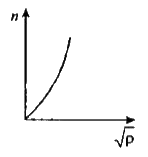The correct graph between the frequency n and square root of density ρ of a wire, keeping its length, radius and tension constant, is




The correct Answer is:C
To determine the correct graph between the frequency n and the square root of density ρ of a wire, while keeping its length, radius, and tension constant, we can follow these steps:
1. Understand the Relationship:
The fundamental frequency f of a wire can be expressed in terms of tension T, length L, and linear mass density μ:
f=12L√Tμ
2. Express Linear Mass Density:
The linear mass density μ can be expressed as:
μ=mV=mA⋅L=ρ⋅AL
where A is the cross-sectional area and ρ is the density.
3. Substitute for Linear Mass Density:
Substitute μ back into the frequency equation:
f=12L√Tρ⋅A
4. Identify Constants:
Since L, A, and T are constant, we can define a new constant k:
k=12L√TA
Thus, the frequency can be rewritten as:
f=k⋅1√ρ
5. Relate Frequency to Density:
This implies that:
n∝1√ρ
or
n=k√ρ
6. Graphical Representation:
If we let x=√ρ, then:
n=kx
This represents a hyperbolic relationship between n and √ρ.
7. Conclusion:
The graph of n versus √ρ will be a hyperbola, indicating that as the square root of density increases, the frequency decreases.
The fundamental frequency f of a wire can be expressed in terms of tension T, length L, and linear mass density μ:
f=12L√Tμ
The linear mass density μ can be expressed as:
μ=mV=mA⋅L=ρ⋅AL
where A is the cross-sectional area and ρ is the density.
Substitute μ back into the frequency equation:
f=12L√Tρ⋅A
Since L, A, and T are constant, we can define a new constant k:
k=12L√TA
Thus, the frequency can be rewritten as:
f=k⋅1√ρ
This implies that:
n∝1√ρ
or
n=k√ρ
If we let x=√ρ, then:
n=kx
This represents a hyperbolic relationship between n and √ρ.
The graph of n versus √ρ will be a hyperbola, indicating that as the square root of density increases, the frequency decreases.
Topper's Solved these Questions
- WAVES BOOK - PHYSICS GALAXY - ASHISH ARORACHAPTER - WAVES EXERCISE - Advance MCQs with One or More Options Correct
30 Videos
- WAVES BOOK - PHYSICS GALAXY - ASHISH ARORACHAPTER - WAVES EXERCISE - Unsolved Numerical Problems for Preparation of NSE, INPhO & IPhO
135 Videos
- WAVES BOOK - PHYSICS GALAXY - ASHISH ARORACHAPTER - WAVES EXERCISE - Conceptual MCQs Single Option Correct
24 Videos
- WAVE OPTICSBOOK - PHYSICS GALAXY - ASHISH ARORACHAPTER - WAVE OPTICSEXERCISE - Unsolved Numerical Problems
28 Videos
- X-RAYSBOOK - PHYSICS GALAXY - ASHISH ARORACHAPTER - X-RAYSEXERCISE - Unsolved Numerica Problem for Preparation
23 Videos
Similar Questions
Draw a graph to show the variation of resistance of a metal wire as a function of its diameter, keeping length and temperature constant.
View SolutionPlot a graph showing the variation of resistance of a conducting wire as function of its radius, keeping the length of a wire and its temperature as constant.
View Solution
Knowledge Check
A sonometer wire is in tnison with a tuning fork of frequency 256 Hz, when the lenghts of the wire between the bridges is 75 cm and only one loop is formed. By keeping the lengths and tension constant, the wire is made to vibrate with 2 loops. The wire can still be in resonance with a tuning fork, provided the freqency of the tuning fork is
A100 HzB512 HzC384 HzD128 HzAssertion : The fundamental frequency of a stretched string is directly proportional to the square root of the tension in the string if length and mass of the string are constant.
Reason : There are n nodes and n antinodes forms when standing waves are formed in a stretched string.AIf both assertion and reason are correct and reason is a correct explanation of the assertion.BIf both assertion and reason are correct but reason is not the correct explanation of assertion.CIf assertion is correct but reason is incorrectDIf assertion is incorrect but reason is correct.Frequency is the function of density (ρ) , length (a) and surface tension (T) . Then its value is
Akρ−1/2a−3/2√TBkρ3/2a3/2/√TCkρ12a32/T3/4Dkρ1/2a1/2/T3/2
Draw a graph between terminal velocity of a spherical body and square of its radius?
View SolutionThe graph between the square root of the frequency of a specific line of characteristic spectrum of X - rays and the atomic number of the target will be
View SolutionFrequency is the function of density ρ, length λ and tension T. The period of oscillation is proporttional to
View SolutionA wire under a tension vibrates with fundamental frequency of 256 Hz . What should be the fundamental frequency of the wire if its length is half, thickness twice and one - fourth of the tension ?
View SolutionIf a wire of resistivity ρ is stretched to double its length then its new resistivity will
View Solution
